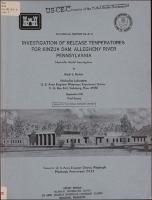Please use this identifier to cite or link to this item:
https://hdl.handle.net/11681/13475| Title: | Investigation of release temperatures for Kinzua Dam, Allegheny River, Pennsylvania : hydrid model investigation |
| Authors: | United States. Army. Corps of Engineers. Pittsburgh District Dortch, Mark S. |
| Keywords: | Hydraulic models Hybrid models Stream temperature Kinzua Dam (Pa.) Thermal measurements Pumped storage Reservoirs Simulation Thermal pollution Allegheny River (Pa. and N.Y.) |
| Publisher: | Hydraulics Laboratory (U.S.) Engineer Research and Development Center (U.S.) |
| Series/Report no.: | Technical report (U.S. Army Engineer Waterways Experiment Station) ; HL-81-9. |
| Description: | Technical Report Abstract: Kinzua Dam, which impounds the Allegheny Reservoir, is a multipurpose project that includes pumped-storage hydropower and flood control. Prior to the construction of Kinzua Dam, the Allegheny River in the vicinity of Kinzua Dam was considered primarily a warmwater stream and supported an important smallmouth bass sport fishery. Since the construction of the dam and power station, stream temperatures below the dam have been colder than expected. To address this problem, a hybrid modeling study was initiated to determine the causes of colder-than-expected releases and to identify and evaluate measures that could be taken to increase the release temperatures. The existing data base alone was insufficient to determine the causes of colder-than-expected releases. Additional temperature data were collected, and the enlarged data base was used to better understand the physical processes to be simulated in a pumped-storage reservoir thermal simulation numerical model. A physical model, scale 1:100, of the inlet-outlet structure and the surrounding Allegheny Reservoir near-field topography was used during the study to determine the selective withdrawal and pumped-storage mixing characteristics. Mathematical thermal model simulations were used to determine the major factors contributing to the release characteristics. Subsequently, the model was used to evaluate various structural and operational modifications to increase release temperatures. The study determined that the pumped-storage operations have not been the cause of the colder-than-desired releases. Pumped-storage actually causes the hypolimnion to warm faster without significant cooling of the epilimnion. Structural modification of the sluices was determined to be the most effective and practical means of releasing warmer water. |
| Rights: | Approved for public release; distribution is unlimited. |
| URI: | http://hdl.handle.net/11681/13475 |
| Appears in Collections: | Technical Report |
Files in This Item:
| File | Description | Size | Format | |
|---|---|---|---|---|
| TR-HL-81-9.pdf | 5.35 MB | Adobe PDF |  View/Open |